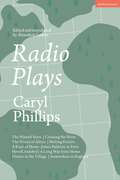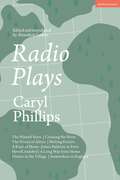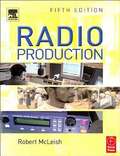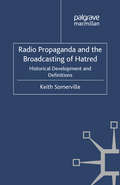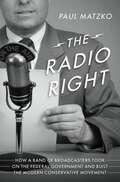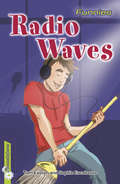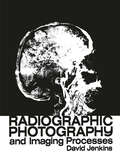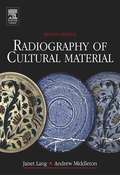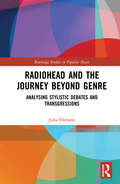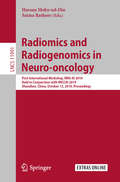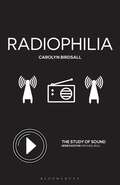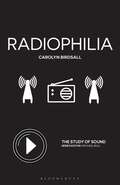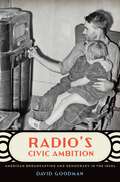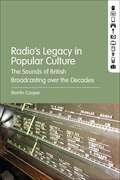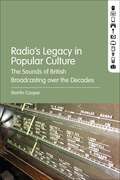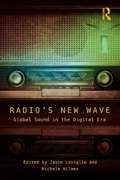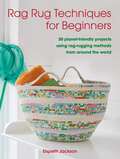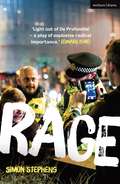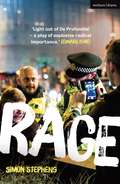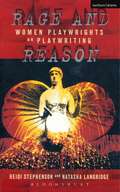- Table View
- List View
Radio Plays: The Wasted Years; Crossing the River; The Prince of Africa; Writing Fiction; A Kind of Home: James Baldwin in Paris; Hotel Cristobel; A Long Way from Home; Dinner in the Village; Somewhere in England
by Caryl PhillipsCaryl Phillips is one of the most respected writers of his generation. An award-winning author best known for his fiction, essays and stage plays, he is also the author of radio plays, nine of which were broadcast by the BBC between 1984 and 2016. Previously locked away in Phillips's archives, housed at the Beinecke Library at Yale University, these hidden gems are now published in Caryl Phillips's Radio Plays, the first collection of these important works of drama. Despite being previously overlooked, these radio plays are fully creative works and constitute an integral part of Caryl Phillips's literary universe. Not only do these dramatic texts display the author's hallmark mix of formal elegance and sharp social criticism, but they also offer compelling points of comparison with the rest of his wider writing. From the experience on an eighteenth-century slave ship and the life of a migrant family in 1980s England, to an account of James Baldwin's time in Paris and Marvin Gaye's stay in Belgium, these plays grapple with expansive themes in creative and dramatic ways. Contextualized by a scholarly introduction by Bénédicte Ledent, this volume introduces these works in the published form for the first time, allowing readers a better grasp of Phillips's narrative techniques, offering fascinating vistas into his imaginary world, which ranges from the history of the African diaspora to the predicament of displaced individuals the world over.
Radio Plays: The Wasted Years; Crossing the River; The Prince of Africa; Writing Fiction; A Kind of Home: James Baldwin in Paris; Hotel Cristobel; A Long Way from Home; Dinner in the Village; Somewhere in England
by Caryl PhillipsCaryl Phillips is one of the most respected writers of his generation. An award-winning author best known for his fiction, essays and stage plays, he is also the author of radio plays, nine of which were broadcast by the BBC between 1984 and 2016. Previously locked away in Phillips's archives, housed at the Beinecke Library at Yale University, these hidden gems are now published in Caryl Phillips's Radio Plays, the first collection of these important works of drama. Despite being previously overlooked, these radio plays are fully creative works and constitute an integral part of Caryl Phillips's literary universe. Not only do these dramatic texts display the author's hallmark mix of formal elegance and sharp social criticism, but they also offer compelling points of comparison with the rest of his wider writing. From the experience on an eighteenth-century slave ship and the life of a migrant family in 1980s England, to an account of James Baldwin's time in Paris and Marvin Gaye's stay in Belgium, these plays grapple with expansive themes in creative and dramatic ways. Contextualized by a scholarly introduction by Bénédicte Ledent, this volume introduces these works in the published form for the first time, allowing readers a better grasp of Phillips's narrative techniques, offering fascinating vistas into his imaginary world, which ranges from the history of the African diaspora to the predicament of displaced individuals the world over.
Radio Production (5th Edition)
by Robert McleishThis classic book is a must-have for anyone involved in radio production, covering everything from operational techniques and producing different programme formats, to conducting interviews and writing for radio.The fifth edition features new and updated information on:* digital production, such as the computer editing process, digital recording and DAB* the internet and internet-only radio stations* automatic playout systems* ethics* storytelling, showing simple ways of creating different acoustics for drama* station management* scheduling* remote reportingThis edition is further enhanced by a supporting CD-Rom, packed with examples, exercises and resources.
Radio Production (5th Edition) (PDF)
by Robert McleishThis classic book is a must-have for anyone involved in radio production, covering everything from operational techniques and producing different programme formats, to conducting interviews and writing for radio.The fifth edition features new and updated information on:* digital production, such as the computer editing process, digital recording and DAB* the internet and internet-only radio stations* automatic playout systems* ethics* storytelling, showing simple ways of creating different acoustics for drama* station management* scheduling* remote reportingThis edition is further enhanced by a supporting CD-Rom, packed with examples, exercises and resources.
Radio Propaganda and the Broadcasting of Hatred: Historical Development and Definitions
by K. SomervilleAn exposition and analysis of the development of propaganda, focusing on how the development of radio transformed the delivery and impact of propaganda and led to the use of radio to incite hatred and violence.
The Radio Right: How a Band of Broadcasters Took on the Federal Government and Built the Modern Conservative Movement
by Paul MatzkoIn the past few years, trust in traditional media has reached new lows. Many Americans disbelieve what they hear from the "mainstream media," and have turned to getting information from media echo chambers which are reflective of a single party or ideology. In this book, Paul Matzko reveals that this is not the first such moment in modern American history. The Radio Right tells the story of the 1960s far Right, who were frustrated by what they perceived to be liberal bias in the national media, particularly the media's sycophantic relationship with the John F. Kennedy administration. These people turned for news and commentary to a resurgent form of ultra-conservative mass media: radio. As networks shifted their resources to television, radio increasingly became the preserve of cash-strapped, independent station owners who were willing to air the hundreds of new right-wing programs that sprang up in the late 1950s and 1960s. By the early 1960s, millions of Americans listened each week to conservative broadcasters, the most prominent of which were clergy or lay broadcasters from across the religious spectrum, including Carl McIntire, Billy James Hargis, and Clarence Manion. Though divided by theology, these speakers were united by their distrust of political and theological liberalism and their antipathy towards JFK. The political influence of the new Radio Right quickly became apparent as the broadcasters attacked the Kennedy administration's policies and encouraged grassroots conservative activism on a massive scale. Matzko relates how, by 1963, Kennedy was so alarmed by the rise of the Radio Right that he ordered the Internal Revenue Service and Federal Communications Commission to target conservative broadcasters with tax audits and enhanced regulatory scrutiny via the Fairness Doctrine. Right-wing broadcasters lost hundreds of stations and millions of listeners. Not until the deregulation of the airwaves under the Carter and Reagan administrations would right-wing radio regain its former prominence. The Radio Right provides the essential pre-history for the last four decades of conservative activism, as well as the historical context for current issues of political bias and censorship in the media.
The Radio Right: How a Band of Broadcasters Took on the Federal Government and Built the Modern Conservative Movement
by Paul MatzkoIn the past few years, trust in traditional media has reached new lows. Many Americans disbelieve what they hear from the "mainstream media," and have turned to getting information from media echo chambers which are reflective of a single party or ideology. In this book, Paul Matzko reveals that this is not the first such moment in modern American history. The Radio Right tells the story of the 1960s far Right, who were frustrated by what they perceived to be liberal bias in the national media, particularly the media's sycophantic relationship with the John F. Kennedy administration. These people turned for news and commentary to a resurgent form of ultra-conservative mass media: radio. As networks shifted their resources to television, radio increasingly became the preserve of cash-strapped, independent station owners who were willing to air the hundreds of new right-wing programs that sprang up in the late 1950s and 1960s. By the early 1960s, millions of Americans listened each week to conservative broadcasters, the most prominent of which were clergy or lay broadcasters from across the religious spectrum, including Carl McIntire, Billy James Hargis, and Clarence Manion. Though divided by theology, these speakers were united by their distrust of political and theological liberalism and their antipathy towards JFK. The political influence of the new Radio Right quickly became apparent as the broadcasters attacked the Kennedy administration's policies and encouraged grassroots conservative activism on a massive scale. Matzko relates how, by 1963, Kennedy was so alarmed by the rise of the Radio Right that he ordered the Internal Revenue Service and Federal Communications Commission to target conservative broadcasters with tax audits and enhanced regulatory scrutiny via the Fairness Doctrine. Right-wing broadcasters lost hundreds of stations and millions of listeners. Not until the deregulation of the airwaves under the Carter and Reagan administrations would right-wing radio regain its former prominence. The Radio Right provides the essential pre-history for the last four decades of conservative activism, as well as the historical context for current issues of political bias and censorship in the media.
Radio Waves (Freestylers: Funnies #3)
by Tom EastonDan's latest work experience trial is at a radio station. All Dan has to do is mop floors. What could possibly go wrong?
Radiographic Photography and Imaging Processes
by D.J. JenkinsThe imaging aspects of radiography have undergone con many sources and was in general freely given when requested siderable change in the last few years and as a teacher of and this is gratefully acknowledged. In particular I would radiography for many years I have often noticed the lack of a like to express my sincere thanks for help and information to comprehensive reference book for students. This book is an Mr J. Day of DuPont (UK) Ltd. particularly for the infor attempt to correct that situation and I hope this text will be mation and illustrations in the chapter on automated film of value not only to student radiographers but also prac handling; Mr D. Harper and Mr R. Black of Kodak Ltd. ; tising radiographers as well. Fujimex Ltd. ; CEA of Sweden; 3M (UK) Ltd. ; Wardray Much of the information is based on personal experiment Products Ltd. ; D. A. Pitman Ltd. ; Agfa-Gevaert; PSR Ltd. and the knowledge gained of students' difficulties in studying for their help with information on silver recovery, and this subject. I have attempted to gather together in one book Radiatron Ltd. for their help with safelighting. All were most all the information required to understand the fundamentals helpful in my many requests for information. of the subject both for examination and for practice. Some To Mrs A. Dalton and Mrs P.
Radiography of Cultural Material
by Julia Tum Andrew MiddletonRadiography can be an invaluable tool for the study of a diverse array of cultural materials including metals, ceramics, paper, paintings and human and animal remains. In this book, experts in the field bring to life their experiences with the different materials, describing the techniques that can be employed to discover the stories behind the objects. This second edition, available in paperback for the first time, includes new case studies and images, as well as whole new sections on digital imaging, quality control and animal mummies.
Radiography of Cultural Material
by Julia Tum Andrew MiddletonRadiography can be an invaluable tool for the study of a diverse array of cultural materials including metals, ceramics, paper, paintings and human and animal remains. In this book, experts in the field bring to life their experiences with the different materials, describing the techniques that can be employed to discover the stories behind the objects. This second edition, available in paperback for the first time, includes new case studies and images, as well as whole new sections on digital imaging, quality control and animal mummies.
Radiohead and the Journey Beyond Genre: Analysing Stylistic Debates and Transgressions (Routledge Studies in Popular Music)
by Julia EhmannRadiohead and the Journey Beyond Genre traces the uses and transgressions of genre in the music of Radiohead and studies the band’s varied reception in online and offline media. Radiohead’s work combines traditional rock sounds with a unique and experimental approach towards genre that sets the band apart from the contemporary mainstream. A play with diverse styles and audience expectations has shaped Radiohead’s musical output and opened up debates about genre amongst critics, fans, and academics alike. Interpretations speak of a music that is referential of the past but also alludes to the future. Applying both music- and discourse-analytical methods, the book discusses how genre manifests in Radiohead’s work and how it is interpreted amongst different audience groups. It explores how genre and generic flexibility affect the listeners’ search for musical meaning and ways of discussion. This results in the development of a theoretical framework for the study of genre in individual popular music oeuvres that explores the equal validity of widely differing forms of reception as a multidimensional network of meaning. While Radiohead’s music is the product of an eclectic mixture of musical influences and styles, the book also shows how the band’s experimental stance has increasingly fostered debates about Radiohead’s generic novelty and independence. It asks what remains of genre in light of its past or imminent transgression. Offering new perspectives on popular music genre, transgression, and the music and reception of Radiohead, the book will appeal to academics, students, and those interested in Radiohead and matters of genre. It contributes to scholarship in musicology, popular music, media, and cultural studies.
Radiohead and the Journey Beyond Genre: Analysing Stylistic Debates and Transgressions (Routledge Studies in Popular Music)
by Julia EhmannRadiohead and the Journey Beyond Genre traces the uses and transgressions of genre in the music of Radiohead and studies the band’s varied reception in online and offline media. Radiohead’s work combines traditional rock sounds with a unique and experimental approach towards genre that sets the band apart from the contemporary mainstream. A play with diverse styles and audience expectations has shaped Radiohead’s musical output and opened up debates about genre amongst critics, fans, and academics alike. Interpretations speak of a music that is referential of the past but also alludes to the future. Applying both music- and discourse-analytical methods, the book discusses how genre manifests in Radiohead’s work and how it is interpreted amongst different audience groups. It explores how genre and generic flexibility affect the listeners’ search for musical meaning and ways of discussion. This results in the development of a theoretical framework for the study of genre in individual popular music oeuvres that explores the equal validity of widely differing forms of reception as a multidimensional network of meaning. While Radiohead’s music is the product of an eclectic mixture of musical influences and styles, the book also shows how the band’s experimental stance has increasingly fostered debates about Radiohead’s generic novelty and independence. It asks what remains of genre in light of its past or imminent transgression. Offering new perspectives on popular music genre, transgression, and the music and reception of Radiohead, the book will appeal to academics, students, and those interested in Radiohead and matters of genre. It contributes to scholarship in musicology, popular music, media, and cultural studies.
Radiomics and Radiogenomics in Neuro-oncology: First International Workshop, RNO-AI 2019, Held in Conjunction with MICCAI 2019, Shenzhen, China, October 13, Proceedings (Lecture Notes in Computer Science #11991)
by Hassan Mohy-ud-Din Saima RathoreThis book constitutes the proceedings of the First International Workshop on Radiomics and Radiogenomics in Neuro-oncology, RNO-AI 2019, which was held in conjunction with MICCAI in Shenzhen, China, in October 2019. The 10 full papers presented in this volume were carefully reviewed and selected from 15 submissions. They deal with the development of tools that can automate the analysis and synthesis of neuro-oncologic imaging.
Radiophilia (The Study of Sound)
by Dr. Carolyn BirdsallA century ago, the emergence of radio, along with organized systems of broadcasting, sparked a global fascination with the 'wonder' of sound transmission and reception. The thrilling experience of tuning in to the live sounds of this new medium prompted strong affective responses in its listeners. This book introduces a new concept of radiophilia, defined as the attachment to, or even a love of radio. Treating radiophilia as a dynamic cultural phenomenon, it unpacks the various pleasures associated with radio and its sounds, the desire to discover and learn new things via radio, and efforts to record, re-experience, and share radio. Surveying 100 years of radio from early wireless through to digital audio formats like podcasting, the book engages in debates about fandom, audience participation, listening experience, material culture, and how media relate to affect and emotions.
Radiophilia (The Study of Sound)
by Dr. Carolyn BirdsallA century ago, the emergence of radio, along with organized systems of broadcasting, sparked a global fascination with the 'wonder' of sound transmission and reception. The thrilling experience of tuning in to the live sounds of this new medium prompted strong affective responses in its listeners. This book introduces a new concept of radiophilia, defined as the attachment to, or even a love of radio. Treating radiophilia as a dynamic cultural phenomenon, it unpacks the various pleasures associated with radio and its sounds, the desire to discover and learn new things via radio, and efforts to record, re-experience, and share radio. Surveying 100 years of radio from early wireless through to digital audio formats like podcasting, the book engages in debates about fandom, audience participation, listening experience, material culture, and how media relate to affect and emotions.
Radio's Civic Ambition: American Broadcasting and Democracy in the 1930s
by David GoodmanIn its golden age, American radio both entertained and also fostered programs meant to produce self-governing and opinion-forming individuals, promoting openness to change and tolerance of diversity, familiarity with classical music, and knowledge of world affairs. As author David Goodman argues, the ambitions of radio's golden age have strong significance today as evidence that media regulation in the public interest can have significant and often positive effects.
Radio's Legacy in Popular Culture: The Sounds of British Broadcasting over the Decades
by Martin CooperExamining work by novelists, film-makers, TV producers and songwriters, this book uncovers the manner in which the radio – and the act of listening – has been written about for the past 100 years. Ever since the first public wireless broadcasts, people have been writing about the radio: often negatively, sometimes full of praise, but always with an eye and an ear to explain, and offer an opinion about what they think they have heard. Novelists including Graham Greene, Agatha Christie, Ernest Hemmingway, and James Joyce wrote about characters listening to this new medium with mixtures of delight, frustration, and despair. Clint Eastwood frightened moviegoers half to death in Play Misty for Me, but Lou Reed's Rock & Roll said listening to a New York station had saved Jenny's life. Frasier showed the urbane side of broadcasting, whilst Good Morning Vietnam exploded through transistor radios with a raw energy all of its own. Queen thought that all the audience heard was gaga, even as the Buggles said video had killed the radio star and Tom Petty and the Heartbreakers lamented The Last DJ. This book explores the cultural fascination with radio; the act of listening as a cultural expression – focusing on fiction, films and songs about radio. Martin Cooper, a broadcaster and academic, uses these movies, TV shows, songs, novels and more to tell a story of listening to the radio – as created by these contemporary writers, film-makers, and musicians.
Radio's Legacy in Popular Culture: The Sounds of British Broadcasting over the Decades
by Martin CooperExamining work by novelists, film-makers, TV producers and songwriters, this book uncovers the manner in which the radio – and the act of listening – has been written about for the past 100 years. Ever since the first public wireless broadcasts, people have been writing about the radio: often negatively, sometimes full of praise, but always with an eye and an ear to explain, and offer an opinion about what they think they have heard. Novelists including Graham Greene, Agatha Christie, Ernest Hemmingway, and James Joyce wrote about characters listening to this new medium with mixtures of delight, frustration, and despair. Clint Eastwood frightened moviegoers half to death in Play Misty for Me, but Lou Reed's Rock & Roll said listening to a New York station had saved Jenny's life. Frasier showed the urbane side of broadcasting, whilst Good Morning Vietnam exploded through transistor radios with a raw energy all of its own. Queen thought that all the audience heard was gaga, even as the Buggles said video had killed the radio star and Tom Petty and the Heartbreakers lamented The Last DJ. This book explores the cultural fascination with radio; the act of listening as a cultural expression – focusing on fiction, films and songs about radio. Martin Cooper, a broadcaster and academic, uses these movies, TV shows, songs, novels and more to tell a story of listening to the radio – as created by these contemporary writers, film-makers, and musicians.
Radio's New Wave: Global Sound in the Digital Era
by Jason Loviglio Michele HilmesRadio’s New Wave explores the evolution of audio media and sound scholarship in the digital age. Extending and updating the focus of their widely acclaimed 2001 book The Radio Reader, Hilmes and Loviglio gather together innovative work by both established and rising scholars to explore the ways that radio has transformed in the digital environment. Contributors explore what sound looks like on screens, how digital listening moves us, new forms of sonic expression, radio’s convergence with mobile media, and the creative activities of old and new audiences. Even radio’s history has been altered by research made possible by digital and global convergence. Together, these twelve concise chapters chart the dissolution of radio’s boundaries and its expansion to include a wide-ranging universe of sound, visuals, tactile interfaces, and cultural roles, as radio rides the digital wave into its second century.
Radio's New Wave: Global Sound in the Digital Era
by Jason Loviglio Michele HilmesRadio’s New Wave explores the evolution of audio media and sound scholarship in the digital age. Extending and updating the focus of their widely acclaimed 2001 book The Radio Reader, Hilmes and Loviglio gather together innovative work by both established and rising scholars to explore the ways that radio has transformed in the digital environment. Contributors explore what sound looks like on screens, how digital listening moves us, new forms of sonic expression, radio’s convergence with mobile media, and the creative activities of old and new audiences. Even radio’s history has been altered by research made possible by digital and global convergence. Together, these twelve concise chapters chart the dissolution of radio’s boundaries and its expansion to include a wide-ranging universe of sound, visuals, tactile interfaces, and cultural roles, as radio rides the digital wave into its second century.
Rag Rug Techniques for Beginners
by Elspeth JacksonLearn ten different rag-rugging methods and use them to create 30 stylish and practical items for yourself and your home. In Rag Rug Techniques for Beginners, Elspeth Jackson details ten methods that will help you learn the art of rag rugs, and inspire your craft creativity. Each chapter focuses on a different technique, from Shaggy to Locker Hooking, Loopy to Two-String Loom and more. Elspeth will show you the skills, tools and equipment you'll need for each one, as well as providing advice on choices of fabrics and design. She will help you to identify common mistakes that you might run into, building for you a strong foundation in the craft. Each chapter includes step-by-step instructions for a traditional rug plus two other projects for yourself or your home, such as placemats, bowls, wall hangings and more, so that you can show off the new skills you've learned. Using upcycled fabrics, only a few basic tools and simple techniques, you'll master rag-rugging in no time!
Rage (Modern Plays)
by Simon StephensSimon Stephens' explosive play Rage was written as a counterpoint for Elfriede Jelinek's Wut. Composed as 31 high-energy scenes, each one is based on a series of photos by Joel Goodman which captured the excitement and the mayhem of New Year's Eve 2015/16 in Manchester city centre. Published in the Manchester Evening News the photos quickly went viral in capturing a vital cross-section of a country on the edge. As the clock strikes twelve the celebratory mood turns into violence, racism, marriage proposals and the opening of portals. Enter the madness and get whisked into the hedonism of youth.Rage premiered at the Thalia Theatre, Hamburg in Autumn 2016 and had its UK premiere at the Royal Welsh School of Music and Drama in 2018.
Rage (Modern Plays)
by Simon StephensSimon Stephens' explosive play Rage was written as a counterpoint for Elfriede Jelinek's Wut. Composed as 31 high-energy scenes, each one is based on a series of photos by Joel Goodman which captured the excitement and the mayhem of New Year's Eve 2015/16 in Manchester city centre. Published in the Manchester Evening News the photos quickly went viral in capturing a vital cross-section of a country on the edge. As the clock strikes twelve the celebratory mood turns into violence, racism, marriage proposals and the opening of portals. Enter the madness and get whisked into the hedonism of youth.Rage premiered at the Thalia Theatre, Hamburg in Autumn 2016 and had its UK premiere at the Royal Welsh School of Music and Drama in 2018.
Rage And Reason: Women Playwrights on Playwriting (Plays and Playwrights)
by Bloomsbury PublishingWomen playwrights speak about their art and the theatre in this collection of interviews about a key decade of British drama.Twenty leading contemporary dramatists discuss their work from the perspective of being both writers and women. Each talks about the state of the theatre now, the craft of playwrighting, and the pressures of working within a male dominated environment. The book also features Sarah Kane's very last public interview. 'What I think is so exciting about the response to a number of the plays written by women in the last ten years is that they are popular with audiences - because they've got this quality, this energy and this culture that hasn't been seen much on stage before: a humour, sexiness and wit that's been missing' - Charlotte Keatley
